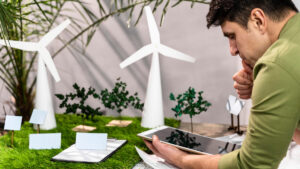Updated by Nazanin Ghodsian, 09/17/2024
Construction sites are high-risk locations where huge teams, complicated jobs, and heavy machines prioritize worker safety. Approximately twenty percent of worker deaths in the private sector are related to construction, according to OSHA. This demonstrates the critical necessity for efficient safety measures, such as a range of alarm button on construction sites that are intended to reduce hazards and promptly handle accidents.
These systems, which guarantee prompt notification during incidents, are essential to site safety and range from conventional pull alarms to Internet of Things (IoT)-enabled options. Through an examination of the features and advantages of each, we learn how these alerts lower the risk of accidents, improve readiness, and support worker safety.
This in-depth examination will center on the many alarm button on construction sites kinds and how they help make construction sites safer—an increasingly important factor as safety regulations change and projects get more complicated. Comprehending these technologies is essential to promoting a safer workplace and guaranteeing the accomplishment of projects.
Table of Contents
Types of Alarm Button on Construction Site
Alarm button on construction sites are essential components of safety systems, providing a quick and direct means of alerting workers and authorities in case of emergencies. Here are several types of alarm buttons commonly used in construction sites:
Suggested article to read: Construction Safety Sensors; Guide to 2024
1. Traditional Pull Stations
In the dynamic landscape of construction safety, traditional pull stations stand as stalwart anchors, serving as fundamental elements in emergency response systems. These simple yet crucial devices have long been integral to construction site safety protocols, providing a manual means of initiating alarm button on construction sites in the event of fire or other emergencies. In this segment, we delve into the essence of traditional pull stations, their mechanics, advantages, and their enduring relevance in construction site safety as of 2024.
Mechanics and Functionality
Traditional pull stations, also known as manual fire alarm stations or call points, typically consist of a sturdy, conspicuous switch or lever mounted on a wall or post. Upon detection of an emergency situation, an individual can physically pull the lever or activate the switch, initiating the alarm button on construction sites. This action triggers audible and visual alerts throughout the construction site, alerting workers to evacuate swiftly and emergency responders to mobilize.
Advantages
- Reliability: One of the primary advantages of traditional pull stations lies in their simplicity and reliability. Unlike more technologically advanced systems that may be susceptible to malfunctions or power outages, pull stations operate mechanically, minimizing the risk of failure.
- Visibility and Accessibility: Positioned strategically in prominent locations, traditional pull stations are readily visible and easily accessible, ensuring that anyone in the vicinity can swiftly activate the alarm button on construction sites in case of an emergency.
- Intuitiveness: The operation of pull stations requires minimal training or technical expertise, making them user-friendly for construction workers of varying skill levels. In high-stress emergency situations, this simplicity can prove invaluable, ensuring swift response times.
- Compatibility: Traditional pull stations are often compatible with a wide range of fire alarm systems, making them versatile components that can be seamlessly integrated into both new construction projects and existing infrastructure.

2. Wireless Panic Buttons
In the ever-evolving landscape of construction safety, wireless panic buttons emerge as innovative tools, revolutionizing the way emergencies are addressed on construction sites. These compact yet powerful devices offer unparalleled flexibility and responsiveness, enhancing the safety and wellbeing of workers amidst the dynamic environment of construction projects. Let’s delve into the intricacies of wireless panic buttons, their functionalities, benefits, and their significance in construction site safety as of 2024.
Functionality and Operation
Wireless panic buttons are compact, portable devices equipped with a button or switch that, when activated, instantly triggers an alarm signal. Unlike their wired counterparts, these buttons operate via wireless communication protocols, transmitting distress signals to designated receivers or central monitoring stations. This instantaneous communication facilitates rapid response times, enabling swift intervention in emergency situations such as accidents, medical emergencies, or security threats.
Advantages
- Mobility and Versatility: One of the key advantages of wireless panic alarm button on construction sites lies in their portability and versatility. Workers can carry these devices with them at all times, whether on-site or during off-site activities, ensuring that emergency assistance is always within reach.
- Rapid Deployment: Wireless alarm button on construction sites can be deployed rapidly without the need for complex wiring or infrastructure modifications. This agility is particularly beneficial in temporary construction sites or during project phases where traditional alarm systems may not be feasible.
- Discreet Alerting: In situations where discretion is paramount, wireless panic buttons offer a discreet means of signaling distress. Workers can activate the alarm without drawing undue attention, allowing for swift intervention without causing panic or disruption.
- Integration with Monitoring Systems: Many wireless panic alarm button on construction sites is compatible with centralized monitoring platforms, enabling real-time tracking of alerts and facilitating coordinated responses. This integration enhances situational awareness and enables supervisors or security personnel to respond promptly to emergencies.
Suggested article to read: Top 11 Construction Safety Tips for 2024
3. Automated Emergency Response Systems
In the dynamic world of construction safety, Automated Emergency Response Systems (AERS) emerge as game-changers, revolutionizing the way emergencies are detected, managed, and mitigated in construction sites. These sophisticated systems integrate cutting-edge technology with streamlined processes to ensure rapid and effective responses to a wide range of emergency situations. In this exploration, we delve into the intricacies of Automated Emergency Response Systems, their functionalities, benefits, and their profound impact on construction site safety as of 2024.
Functionality and Operation
Automated Emergency Response Systems are comprehensive frameworks designed to detect, assess, and respond to emergency situations autonomously or with minimal human intervention. Leveraging an array of sensors, detectors, and communication networks, these systems monitor the construction site environment in real-time, identifying potential hazards or anomalies and initiating appropriate responses accordingly. From fire detection and evacuation coordination to medical emergencies and security threats, AERS are capable of orchestrating multifaceted responses tailored to specific scenarios.
Advantages
- Enhanced Situational Awareness: By continuously monitoring the construction site environment, AERS provide stakeholders with real-time insights into potential hazards and emerging threats. This heightened situational awareness enables proactive risk management and preemptive interventions, reducing the likelihood of accidents or emergencies.
- Rapid Response Times: Automation enables AERS to detect and respond to emergencies with unparalleled speed and efficiency. By eliminating human error and minimizing response latency, these systems ensure that critical interventions are initiated promptly, mitigating the impact of emergencies and saving lives.
- Scalability and Adaptability: AERS are highly scalable and adaptable, capable of accommodating construction projects of varying scales and complexities. Whether deployed in small-scale renovations or large-scale infrastructure projects, these systems can be tailored to meet the unique requirements of each construction site, ensuring comprehensive coverage and effectiveness.
- Data-Driven Insights: The data collected by AERS offer valuable insights into historical trends, incident patterns, and areas of vulnerability within the construction site. By leveraging analytics and predictive modeling, stakeholders can identify recurring issues, optimize safety protocols, and implement targeted interventions to minimize risks and enhance overall safety performance.
4. IoT-Based Alarm Systems
In the ever-evolving realm of construction safety, IoT-based alarm button on construction sites emerge as transformative tools, leveraging the power of interconnected devices and data analytics to enhance emergency preparedness and response. These sophisticated systems harness the Internet of Things (IoT) technology to monitor construction site environments in real-time, detect potential hazards, and facilitate rapid interventions in the event of emergencies. In this discussion, we delve into the intricacies of IoT-based alarm button on construction sites, their functionalities, advantages, and their profound impact on construction site safety as of 2024.
Functionality and Operation
IoT-based Alarm Systems utilize a network of interconnected sensors, actuators, and communication devices to monitor various aspects of the construction site environment. These sensors can detect a wide range of parameters, including temperature, humidity, air quality, motion, and sound levels, among others. Data collected by these sensors are transmitted to a centralized platform via wireless or wired communication channels, where they are analyzed in real-time to identify potential hazards or anomalies. Upon detection of an emergency or predefined trigger condition, the system initiates appropriate response actions, such as sounding alarm button on construction sites, activating safety protocols, or alerting relevant stakeholders.
Advantages
- Proactive Hazard Detection: By continuously monitoring environmental conditions, IoT-based alarm button on construction sites enable proactive detection of potential hazards before they escalate into emergencies. Early detection allows for timely interventions, mitigating risks and minimizing the likelihood of accidents or incidents.
- Real-time Insights: The data collected by IoT-based Alarm Systems provide stakeholders with valuable real-time insights into construction site conditions and safety performance. These insights enable informed decision-making, allowing for the optimization of safety protocols and resource allocation.
- Scalability and Flexibility: IoT-based Alarm Systems are highly scalable and adaptable, capable of accommodating construction projects of varying scales and complexities. Whether deployed in small-scale renovations or large-scale infrastructure projects, these systems can be customized to meet the specific requirements of each construction site.
- Integration with Smart Building Systems: IoT-based alarm button on construction sites can seamlessly integrate with other smart building systems, such as Building Management Systems (BMS) and Energy Management Systems (EMS). This integration enables holistic management of construction site operations, enhancing efficiency, sustainability, and safety.
Suggested article to read: Sensors in Construction: Ultimate Guide 2024
5. Mobile App-Based Alarms
In the era of smartphones and digital connectivity, mobile app-based alarms emerge as dynamic tools for enhancing safety in construction sites. These innovative applications leverage the ubiquity of mobile devices to provide construction workers with instant access to emergency alerts, communication channels, and critical safety information. In this discussion, we explore the functionality, benefits, and significance of mobile app-based alarms in construction site safety as of 2024.
Functionality and Operation
Mobile app-based alarm button on construction sites utilize dedicated applications installed on smartphones or tablets to deliver real-time emergency alarm button on construction sites and communication capabilities to construction workers. These applications are typically integrated with centralized monitoring systems or emergency response platforms, allowing for seamless coordination and dissemination of critical information. Upon detection of an emergency situation, the app triggers audible alarms, visual alerts, and push notifications to notify users of the potential hazard and provide guidance on appropriate response actions.
Advantages
- Accessibility: Mobile app-based alarm button on construction sites provide construction workers with instant access to safety information and emergency alerts directly on their smartphones or tablets, ensuring that critical information is always within reach, even in noisy or chaotic environments.
- Real-time Updates: By delivering real-time alerts and updates, mobile app-based alarms enable construction workers to stay informed about evolving safety hazards, weather conditions, or other factors that may impact their work environment.
- Enhanced Communication: Two-way communication capabilities allow construction workers to communicate with supervisors or emergency responders quickly and efficiently, facilitating coordinated responses to emergencies and ensuring that assistance is provided promptly.
- User-Friendly Interface: Mobile app-based alarm button on construction sites typically feature intuitive interfaces and user-friendly designs, making them accessible to workers of all skill levels without the need for extensive training or technical expertise.

6. Voice-Activated Alarm Systems
In the pursuit of safer construction environments, voice-activated alarm button on construction sites emerge as innovative solutions, leveraging the power of voice recognition technology to enhance emergency response capabilities. These advanced systems enable construction workers to initiate alarms, communicate distress signals, and access critical safety information using voice commands, thereby streamlining emergency procedures and ensuring rapid intervention. In this exploration, we delve into the functionality, advantages, and significance of voice-activated alarm systems in construction site safety as of 2024.
Functionality and Operation
Voice-activated alarm button on construction sites utilize sophisticated voice recognition algorithms to interpret spoken commands and initiate corresponding actions. Construction workers can trigger alarms, request assistance, or access safety information by simply speaking into designated microphones or wearable devices equipped with voice recognition capabilities. Upon receiving a voice command, the system validates the input, identifies the intended action, and executes the necessary response, such as sounding alarms, activating communication channels, or providing procedural guidance.
Advantages
- Efficiency and Speed: Voice-activated alarm systems enable rapid initiation of alarms and communication of distress signals, reducing response times and facilitating swift intervention in emergencies.
- Hands-Free Operation: The hands-free operation of these alarm button on construction sites allows construction workers to initiate alarms and access safety features without interrupting their tasks or compromising their safety by manually interacting with devices.
- Accessibility: Voice-activated alarm systems enhance accessibility for workers with limited mobility or dexterity, enabling them to participate in emergency procedures and communicate distress signals effectively using voice commands.
- User-Friendly Interface: The intuitive nature of voice-activated commands makes these systems user-friendly and accessible to workers of all skill levels, minimizing the need for extensive training or technical expertise.
Suggested article to read: What is Emergency Alarm in Construction Site & How to Respond?
7. Wearable Emergency Alert Devices
In the pursuit of heightened safety measures in construction sites, wearable emergency alert devices emerge as pivotal tools, empowering workers with immediate access to assistance in times of need. These compact yet powerful devices are designed to be worn by construction personnel, providing them with a means to quickly and discreetly summon help in the event of an emergency. In this exploration, we delve into the functionalities, advantages, and significance of wearable emergency Alarm button on construction sites safety as of 2024.
Functionality and Operation
Wearable emergency alarm button on construction sites are typically compact, lightweight devices that can be worn on the body, such as on a wristband, lanyard, or clipped to clothing. These devices are equipped with a variety of features designed to facilitate emergency communication and response, including panic buttons, GPS tracking, two-way communication capabilities, and motion sensors. In the event of an emergency, construction workers can activate the device to trigger an alert, which is then transmitted to a centralized monitoring system or directly to designated responders.
Advantages
- Rapid Response: Wearable emergency alert devices enable construction workers to summon help rapidly in the event of an emergency, reducing response times and ensuring that assistance is provided without delay.
- Discreet Alerting: The compact and discreet nature of wearable devices allows users to activate emergency alerts discreetly, without drawing attention to themselves or escalating panic among coworkers.
- Enhanced Safety: By providing construction workers with immediate access to assistance, wearable emergency alert devices enhance overall safety on construction sites, reducing the risk of injury or harm in emergency situations.
- Peace of Mind: The presence of wearable emergency alarm button on construction sites provides peace of mind to both workers and supervisors, knowing that help is always within reach in the event of an emergency.
Conclusion
In the diverse landscape of construction site safety, the array of alarm button on construction sites available serves as a testament to the industry’s commitment to safeguarding its workforce and assets. From traditional pull stations to cutting-edge wearable devices, each type of alarm button plays a crucial role in facilitating rapid response and mitigating risks in emergency situations.
Traditional pull stations embody reliability and simplicity, offering a manual means of initiating alarms that have stood the test of time. On the other end of the spectrum, wireless panic alarm button on construction sites provide unparalleled flexibility and mobility, empowering workers to summon help with the press of a button wherever they may be on-site.
Meanwhile, automated emergency response systems leverage advanced technology to detect and manage emergencies autonomously, ensuring swift and coordinated interventions. IoT-based alarm systems harness the power of interconnected devices to provide real-time insights and proactive hazard detection, while mobile app-based alarms offer accessibility and communication capabilities through ubiquitous smartphone platforms.
Voice-activated alarm systems introduce a new dimension of hands-free operation and intuitive communication, while wearable emergency alert devices provide discreet yet rapid means of summoning assistance.
Together, these diverse types of alarm buttons form a comprehensive safety net, enabling construction sites to navigate the dynamic and often hazardous environments with confidence. As construction practices evolve and safety standards continue to advance, the continued innovation and integration of these alarm systems will be essential in ensuring the wellbeing of construction workers and the success of projects. Ultimately, it is through the collective efforts and commitment to safety that construction sites can strive towards a future where emergencies are met with swift and effective responses, and every worker returns home safely at the end of the day.
FAQs
What is the Purpose of Traditional Pull Stations on Construction Sites?
- Answer: In the event of an emergency, such as a fire, employees can manually activate manual pull stations by pulling a lever, which guarantees prompt evacuation and response.
How do Wireless Panic Buttons Enhance Safety in Construction?
- Answer: Without the need for cabling, wireless panic buttons enable employees to transmit emergency signals immediately. They also offer mobility, quick deployment, and interaction with centralized systems.
What are Automated Emergency Response Systems (AERS)?
- Answer: AERS are systems that use sensors to automatically identify and react to crises, reducing the need for human intervention and facilitating quicker, data-driven decisions.
How do IoT-based Alarm Systems Work on Construction Sites?
- Answer: IoT-based alarm systems monitor environmental variables in real-time using networked sensors, automatically sounding alarms and taking appropriate action when potentially dangerous situations are identified.
What are the Advantages of Wearable Emergency Alert Devices?
- Answer: Wearable technology ensures a prompt and discrete reaction in emergency scenarios by giving workers instant access to emergency assistance through features like GPS tracking and panic buttons.
Suggested article for reading:
Workflow Automation in Construction, The Ultimate Guide for 2024
What is GDPR in Wearable IoT? Safeguarding Privacy in 2024
Introducing GDPR-Compliant Sensors: The Future of Data Security in Construction
Nearly Zero Energy Buildings (NZEB); Ultimate Guide 2024
Preconstruction; Everything You Need to Know in 2024
Resources:
Evacuator Alarms | Safelincs | Flixfire | Intercoms Online | Rogeer Williams University | HSE study guide | IOP Science | OSHA | safe Reach | Iowa State University
For all the pictures: Freepik





